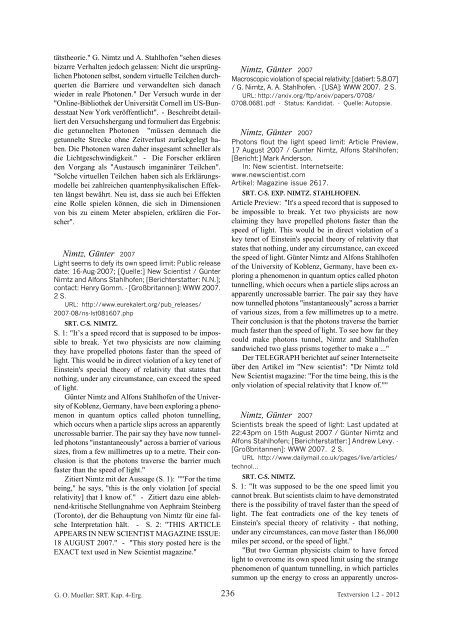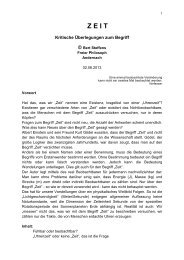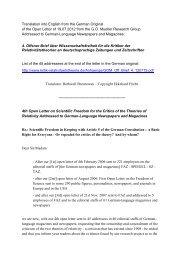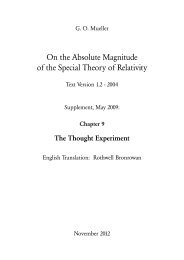2394 weitere kritische Veröffentlichungen - Kritische Stimmen zur ...
2394 weitere kritische Veröffentlichungen - Kritische Stimmen zur ...
2394 weitere kritische Veröffentlichungen - Kritische Stimmen zur ...
Sie wollen auch ein ePaper? Erhöhen Sie die Reichweite Ihrer Titel.
YUMPU macht aus Druck-PDFs automatisch weboptimierte ePaper, die Google liebt.
tätstheorie." G. Nimtz und A. Stahlhofen "sehen dieses<br />
bizarre Verhalten jedoch gelassen: Nicht die ursprünglichen<br />
Photonen selbst, sondern virtuelle Teilchen durchquerten<br />
die Barriere und verwandelten sich danach<br />
wieder in reale Photonen." Der Versuch wurde in der<br />
"Online-Bibliothek der Universität Cornell im US-Bundesstaat<br />
New York veröffentlicht". - Beschreibt detailliert<br />
den Versuchshergang und formuliert das Ergebnis:<br />
die getunnelten Photonen "müssen demnach die<br />
getunnelte Strecke ohne Zeitverlust <strong>zur</strong>ückgelegt haben.<br />
Die Photonen waren daher insgesamt schneller als<br />
die Lichtgeschwindigkeit." - Die Forscher erklären<br />
den Vorgang als "Austausch imganinärer Teilchen".<br />
"Solche virtuellen Teilchen haben sich als Erklärungsmodelle<br />
bei zahlreichen quantenphysikalischen Effekten<br />
längst bewährt. Neu ist, dass sie auch bei Effekten<br />
eine Rolle spielen können, die sich in Dimensionen<br />
von bis zu einem Meter abspielen, erklären die Forscher".<br />
Nimtz, Günter 2007<br />
Light seems to defy its own speed limit: Public release<br />
date: 16-Aug-2007; [Quelle:] New Scientist / Günter<br />
Nimtz and Alfons Stahlhofen; [Berichterstatter: N.N.];<br />
contact: Henry Gomm. - [Großbritannen]: WWW 2007.<br />
2 S.<br />
URL: http://www.eurekalert.org/pub_releases/<br />
2007-08/ns-lst081607.php<br />
SRT. C-S. NIMTZ.<br />
S. 1: "It’s a speed record that is supposed to be impossible<br />
to break. Yet two physicists are now claiming<br />
they have propelled photons faster than the speed of<br />
light. This would be in direct violation of a key tenet of<br />
Einstein's special theory of relativity that states that<br />
nothing, under any circumstance, can exceed the speed<br />
of light.<br />
Günter Nimtz and Alfons Stahlhofen of the University<br />
of Koblenz, Germany, have been exploring a phenomenon<br />
in quantum optics called photon tunnelling,<br />
which occurs when a particle slips across an apparently<br />
uncrossable barrier. The pair say they have now tunnelled<br />
photons "instantaneously" across a barrier of various<br />
sizes, from a few millimetres up to a metre. Their conclusion<br />
is that the photons traverse the barrier much<br />
faster than the speed of light."<br />
Zitiert Nimtz mit der Aussage (S. 1): ""For the time<br />
being," he says, "this is the only violation [of special<br />
relativity] that I know of." - Zitiert dazu eine ablehnend-<strong>kritische</strong><br />
Stellungnahme von Aephraim Steinberg<br />
(Toronto), der die Behauptung von Nimtz für eine falsche<br />
Interpretation hält. - S. 2: "THIS ARTICLE<br />
APPEARS IN NEW SCIENTIST MAGAZINE ISSUE:<br />
18 AUGUST 2007." - "This story posted here is the<br />
EXACT text used in New Scientist magazine."<br />
G. O. Mueller: SRT. Kap. 4-Erg.<br />
236<br />
Nimtz, Günter 2007<br />
Macroscopic violation of special relativity: [datiert: 5.8.07]<br />
/ G. Nimtz, A. A. Stahlhofen. - [USA]: WWW 2007. 2 S.<br />
URL: http://arxiv.org/ftp/arxiv/papers/0708/<br />
0708.0681.pdf - Status: Kandidat. - Quelle: Autopsie.<br />
Nimtz, Günter 2007<br />
Photons flout the light speed limit: Article Preview,<br />
17 August 2007 / Gunter Nimtz, Alfons Stahlhofen;<br />
[Bericht:] Mark Anderson.<br />
In: New scientist. Internetseite:<br />
www.newscientist.com<br />
Artikel: Magazine issue 2617.<br />
SRT. C-S. EXP. NIMTZ. STAHLHOFEN.<br />
Article Preview: "It's a speed record that is supposed to<br />
be impossible to break. Yet two physicists are now<br />
claiming they have propelled photons faster than the<br />
speed of light. This would be in direct violation of a<br />
key tenet of Einstein's special theory of relativity that<br />
states that nothing, under any circumstance, can exceed<br />
the speed of light. Günter Nimtz and Alfons Stahlhofen<br />
of the University of Koblenz, Germany, have been exploring<br />
a phenomenon in quantum optics called photon<br />
tunnelling, which occurs when a particle slips across an<br />
apparently uncrossable barrier. The pair say they have<br />
now tunnelled photons "instantaneously" across a barrier<br />
of various sizes, from a few millimetres up to a metre.<br />
Their conclusion is that the photons traverse the barrier<br />
much faster than the speed of light. To see how far they<br />
could make photons tunnel, Nimtz and Stahlhofen<br />
sandwiched two glass prisms together to make a ..."<br />
Der TELEGRAPH berichtet auf seiner Internetseite<br />
über den Artikel im "New scientist": "Dr Nimtz told<br />
New Scientist magazine: "For the time being, this is the<br />
only violation of special relativity that I know of.""<br />
Nimtz, Günter 2007<br />
Scientists break the speed of light: Last updated at<br />
22:43pm on 15th August 2007 / Günter Nimtz and<br />
Alfons Stahlhofen; [Berichterstatter:] Andrew Levy. -<br />
[Großbritannen]: WWW 2007. 2 S.<br />
URL http://www.dailymail.co.uk/pages/live/articles/<br />
technol...<br />
SRT. C-S. NIMTZ.<br />
S. 1: "It was supposed to be the one speed limit you<br />
cannot break. But scientists claim to have demonstrated<br />
there is the possibility of travel faster than the speed of<br />
light. The feat contradicts one of the key tenets of<br />
Einstein's special theory of relativity - that nothing,<br />
under any circumstances, can move faster than 186,000<br />
miles per second, or the speed of light."<br />
"But two German physicists claim to have forced<br />
light to overcome its own speed limit using the strange<br />
phenomenon of quantum tunnelling, in which particles<br />
summon up the energy to cross an apparently uncros-<br />
Textversion 1.2 - 2012





